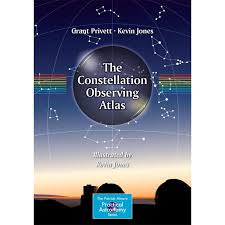The Universe is filled with hot fusion, in the cores of stars. And scientists have even been able to replicate this stellar process in expensive experiments. But wouldn’t it be amazing if you could produce energy from fusion without all that equipment, and high temperatures and pressures? Pons and Fleischmann announced exactly that back in 1989, but things didn’t quite turn out as planned…
Book Review and Giveaway: The Constellation Observing Atlas
Here is another giveaway just in time for the holidays: The Constellation Observing Atlas by Grant Privett and Kevin Jones. Springer and Universe Today are giving away free copies to two lucky Universe Today readers.
Review by: Evan Gough
The night sky is vast and full of wonders, and binoculars or a telescope can bring these wonders into view. The planets and the moon are easy to find, but after that, the rest of the objects in the night sky can be challenging to locate. “The Constellation Observing Atlas,” by Grant Privett and Kevin Jones, will guide you around the night sky, and help you find the most interesting objects.
This atlas uses the patterns of the constellations to cut the sky up into bite-sized pieces, giving the amateur observer an easy to use method for exploring the night sky. “The Constellation Observing Atlas” has a section for each one of the eighty-eight constellations recognized by the International Astronomical Union, from Andromeda to Vulpecula.
General information about each constellation is included, followed by the history of its name and mapping, any notable double and variable stars are mentioned and any deep sky objects that reside in or near the constellation are listed. Along with some nice images, “The Constellation Observing Atlas” also has detailed maps of each constellation which helps make the observing process straightforward.
The book is well laid out, and the amount of information for each constellation is just right. The maps are detailed and helpful and I found the history sections very interesting and amusing. The authors don’t mind having a little fun at the ancient’s expense for some of their comical constellation choices and the convoluted myths behind them, and who can blame them? Many of the constellations are just vague clumps and arrangements of stars in which the ancients somehow saw their most powerful gods, mythical creatures, and heroes.
Like many Universe Today readers, I’m interested in all things astronomy and space, but I’m far from an expert observer. “The Constellation Observing Atlas” tries to make the night sky accessible for amateurs like myself, and it works. You simply locate a constellation in the sky, check the book for interesting viewing targets, point your ‘scope around, and have some fun. Some of the stars and deep sky objects will be challenging to find, and the authors give detailed information for finding these elusive targets.
In my part of the world, winter has come and I’m in store for some clear, cold, crisp nights. There should be some great observing conditions ahead, with Orion prominent in the night sky. I’m looking forward to using “The Constellation Observing Atlas” to expand my observing. The authors have done a good job of being informative and fun, and I highly recommend this book to amateur and novice observers. It makes the wonders of the night sky accessible, one constellation at a time.
In order to be entered into the giveaway drawing, just put your email address into the box at the bottom of this post (where it says “Enter the Giveaway”) before Monday, December 16th, 2013. We’ll send you a confirmation email, so you’ll need to click that to be entered into the drawing.
Don’t want to wait to see if you won? Get your copy in time for Christmas from Amazon.com
Take a Virtual Spin Around Mars’ North Pole

Get a satellite’s-eye view of the Martian north pole in this new animation from the Mars Express spacecraft, using data from the Mars Advanced Radar for Subsurface and Ionospheric Sounding instrument, MARSIS. This instrument allows for studying the surface heights, providing a 3-D view of the Mars’ north pole.
You can see the prominent gap in the ice cap, which is a 318 km-long, 2 km-deep chasm called Chasma Boreale.
In all, the ice cap has a diameter of about 1000 km and consists of many thin layers of ice mixed with dust that extend to a depth of around 2 km below the cap.
ESA says the layers result from variations in the orbit and rotation of Mars that affect the amount of sunlight received at the poles, and thus the amount of melting and deposition of materials over time. Meanwhile, strong prevailing winds are thought to be responsible for shaping the spiral troughs.
The MARSIS instrument works by sending low-frequency radio waves towards the surface of Mars, and they are reflected back to the spacecraft from the planet’s surface. The strength and timing of the radar echoes are a gauge of the depths of different types of interfaces, such as between rock, water or ice.
Video credit: ESA/ASI/NASA/JPL/La Sapienza University/INAF (A. Frigeri)
‘Glowing Wreck Of A Star’ Reveals Cosmic Cannibalism
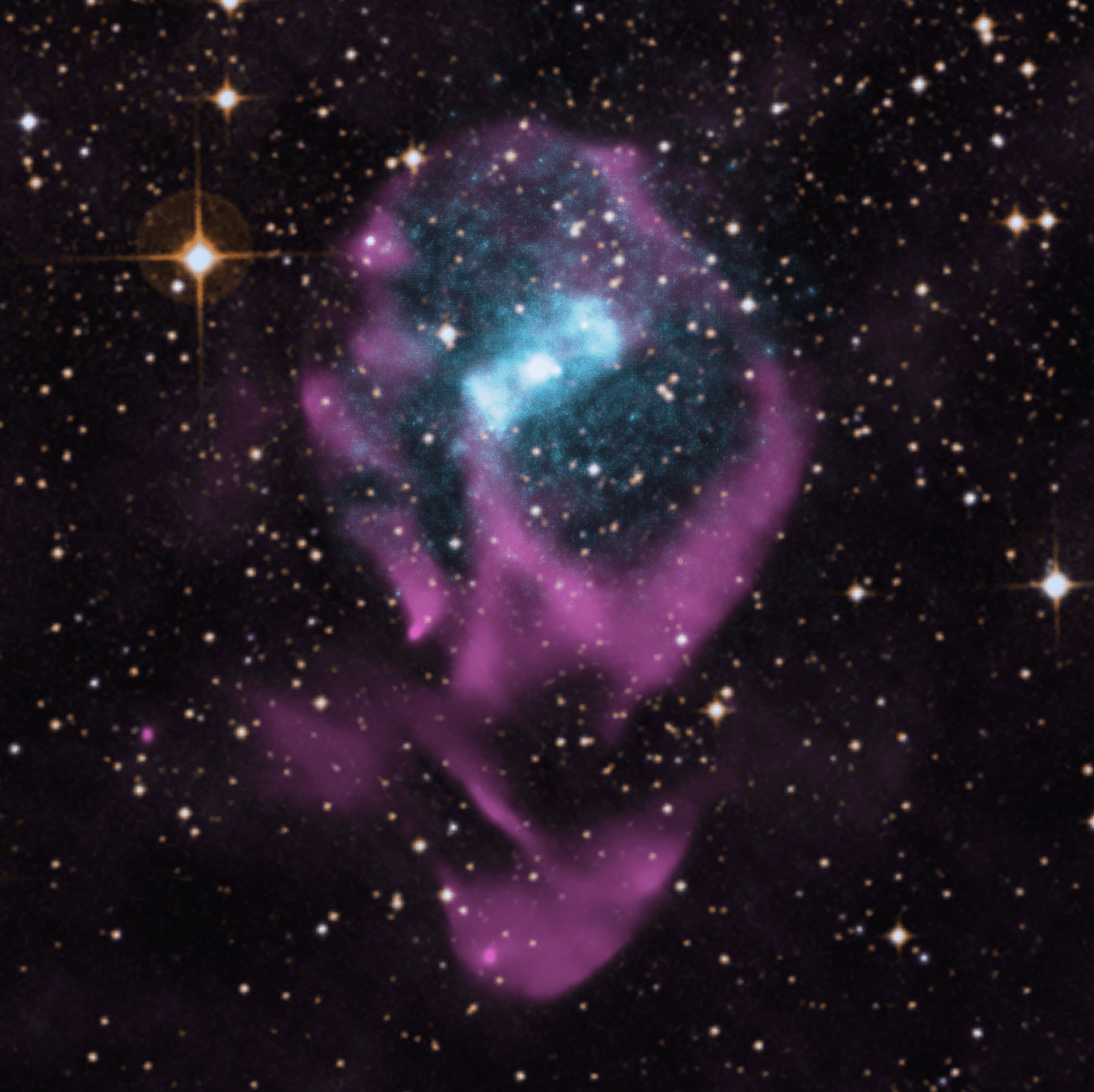
Circinus X-1 may look like a serene place from a distance, but in reality this gassy nebula is quite a busy spot. Embedded in the nebula is the neutron star that is also a leftover of the supernova that produced the gas. Not only that, but the neutron star is still locked on to a companion and is in fact “cannibalizing” it, astronomers said.
The “glowing wreck of a star”, as the team called it, is exciting because it demonstrates what systems look like in the first stages after an explosion. The nebula is an infant in cosmic terms, with an upper limit to its age of just 4,500 years. To put that in human terms, that’s around the time of the first civilizations (such as in Mesopotamia).
“The fact that we have this remnant along with the neutron star and its companion means we can test all kinds of things,” stated Sebastian Heinz, an astronomy professor at the University of Wisconsin-Madison who led the research.
“Our observations solve a number of puzzles both about this object and the way that neutron stars evolve after they are born. For example, the unusual elliptical orbit on which these two stars swing around each other is exactly what you would expect for a very young X-ray binary.”
X-ray binaries are typically made up of a black hole or a neutron star that is locked on to a “normal” companion star such as that of our sun. That star won’t stay normal forever, however, as it’s being subject to very intense gravity from the black hole or neutron star. Its starstuff is being pulled off, heated, and then emitting radiation in X-rays that are easily trackable across the universe.
While X-ray binaries have been spotted before, seeing one along with a nebula is something special. By comparison, the gas cloud doesn’t stick around for very long — just 100,000 years or so — while the stars can be there for a while longer.
Checking out this star system could not only teach scientists about stellar evolution, but about the nature of neutron stars. One thing puzzling the team right now is why the neutron star has a faint magnetic field, which stands against established theory. Further study will be required to figure out why it isn’t as strong as expected.
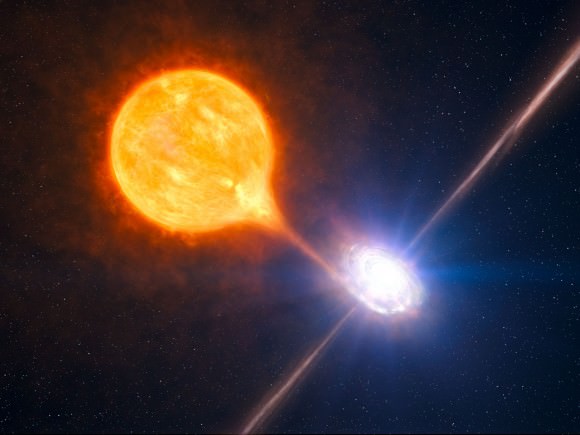
This high-resolution view from NASA’s Chandra X-Ray Telescope and the Australia Telescope Compact Array, however, has revealed some new things.
“I have been perplexed by the unusually strong evolution of the orbit of Circinus X-1 since my graduate-school days,” stated Niel Brandt, an astronomer at Pennsylvania State University who is on the team. “The discovery now of this system’s youth provides a satisfying explanation for why its orbit evolves so strongly — because the system likely still is settling down after its violent birth.”
You can read more in the Dec. 4 publication in The Astrophysical Journal or, in prepublished form, on Arxiv.
Sources: University of Wisconsin-Madison and Pennsylvania State University
Get Ready for the 2013 Geminid Meteor Shower
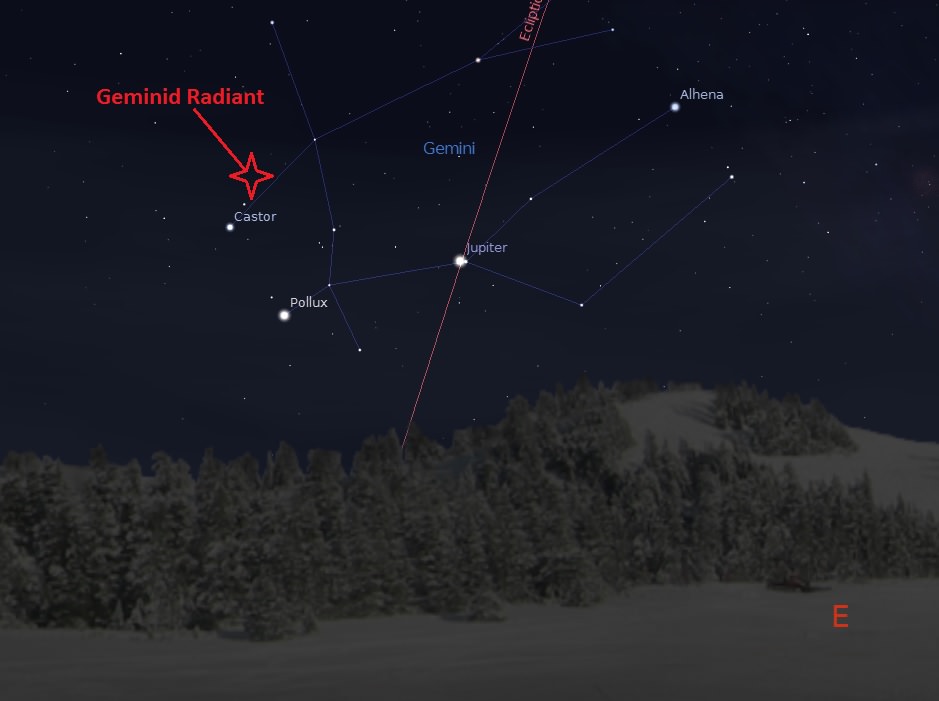
One of the best annual meteor showers occurs this coming weekend.
The 2013 Geminid meteors peak this coming Saturday on December 14th. This shower has a broad maximum, assuring that observers worldwide get a good look. In 2013, the maximum for the Geminids is forecast to span from 13:00 Universal Time (UT) on Friday, December 13th to 10:00UT/5:00AM EST on Saturday, December 14th, with a projected maximum centered a few hours earlier at 2:00 UT Saturday morning.
This is good news for observers spanning both sides of the Atlantic, who should be well placed to catch the event. Keep in mind, meteor showers often peak hours before or after predictions… we certainly don’t know everything that a given meteor stream might have in store!
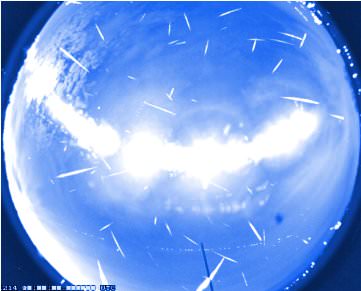
But the time to start watching is now. We’ve already seen a few early Geminids this past weekend, and this shower is notable for showing early activity for northern hemisphere observers before local midnight. This is because the radiant, or the direction that the meteors seem to emanate from lies at a high northern declination of 33 degrees north near the star Castor, also known as Alpha Geminorum.
The typical Zenithal Hourly Rate for the Geminids is 80-120, or about 1 to 2 per minute. Keep in mind, the ZHR is an ideal rate, assuming dark skies, with the radiant positioned directly overhead. Most observers will see significantly less activity.
The 2013 Geminids also have to contend with the waxing gibbous Moon, which reaches Full just 3 days after the shower’s expected maximum. This will give observers a dwindling window between moonset and the start of dawn twilight to catch the Geminids at their best.
We always thought that the Geminids had a bit of an undeserved PR problem among annual showers. This no doubt stems from the fact that they arrive in the chilly month of December, a time when fingers go numb, camera batteries die, and conducting a vigil for meteors is challenging.
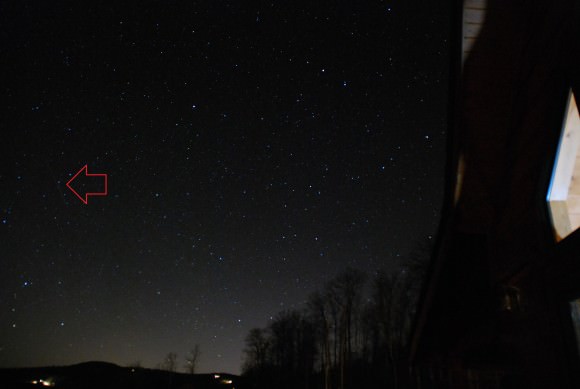
This shower is an interesting one though, with an equally interesting history and source. The Geminids were first identified as a distinct meteor shower by R.P. Greg of Manchester UK in 1862, and the estimated ZHR rose from about 20 to 80 through the 20th century. The parent source of the Geminids remained unknown until 1983, when astronomer Fred Whipple linked them to the strange “rock-comet” body 3200 Phaethon. An Apollo asteroid also thought to be a member of the Pallas family of asteroids, 3200 Phaethon seems to be shedding enough material to produce the annual Geminid meteor shower. This makes the annual shower rare as one not produced by a comet. It’s worth noting that 3200 Phaethon also passes extremely close – 0.14 AU – from the Sun at perihelion, and gets periodically “baked” during each 1.4 year passage.
In the 21st century, rates for the Geminids have stayed above a ZHR of 120, currently the highest of any annual shower. It’s worth noting that an extrapolated ZHR of almost 200 were seen in 2011 when the Moon was at an equally unfavorable waning gibbous phase! The Geminids always produce lots of fireballs, capable of being seen even under moonlit skies.
There are also two other showers currently active to watch for this week. One is the Ursid meteors, which radiate from the Little Dipper (Ursa Minor) with a peak ZHR of 10-50 occurring on December 22nd. Also, keep an eye out for Andromedid meteors this week, a defunct shower that may be making a comeback. The source of several great meteor storms in the late 19th century, the Andromedid parent source is the shattered comet formerly known as 3D/Biela.
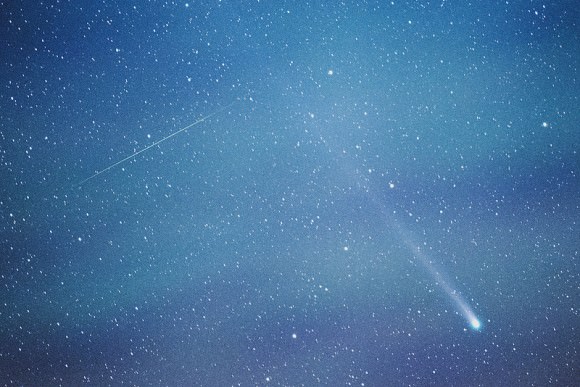
Though the Geminids appear to radiate from the constellation Gemini, they can appear anywhere in the sky. Tracing the path back can determine the source constellation and the “membership” of a given meteor. Random meteors not associated with any identified shower are known as “sporadics.” Block that pesky light-polluting Moon behind a building or hill to optimize your chances of catching sight of a meteor. Employing a friend or two to watch in different directions will also maximize the number seen. The International Meteor Organization always welcomes reports from observers… this is real science that you can contribute to using nothing more sophisticated than your eyes!
The Geminids are medium-speed meteors with an average atmospheric velocity of about 35 kilometres per second, often leaving long, glowing trails worth examining with a pair of binoculars. You might note an apparent surge in speed to this shower past local midnight, as your vantage point turns into the oncoming shower, adding the velocity of the Earth to the approaching Geminids.
Photographing meteors is fun and easy to do; all you’ll need is a DSLR camera mounted on a tripod. Take several manual setting exposures to get the combination of ISO,F-stop, and shutter speed correct for your local sky conditions. Then simply set the focus to infinity, and use the widest field of view possible. Catching meteors is surreptitious, as they can appear anywhere – and at any time – in the sky. Be sure to thoroughly review those images afterwards… nearly every meteor we’ve caught photographically went unnoticed during observation!
Also, remember that cold weather plus long exposure times can conspire to drain camera batteries in a hurry. Be sure to keep a spare set of charged batteries ready to go in a warm pocket!
How powerful will the Geminids become? Are we in for a “return of the Andromedids” moving towards 2014? One thing is for sure: you won’t see any meteors if you don’t try. So be sure to get out there, pour a mug of your favorite warming beverage, and don’t miss the 2013 Geminid meteor shower!
– Got meteors? Be sure and tweet ‘em to #Meteorwatch.
– Be sure to send those pics of Geminids and more in to Universe Today.
This Spooky X-Ray ‘Hand’ Demonstrates A Pulsar Star Mystery
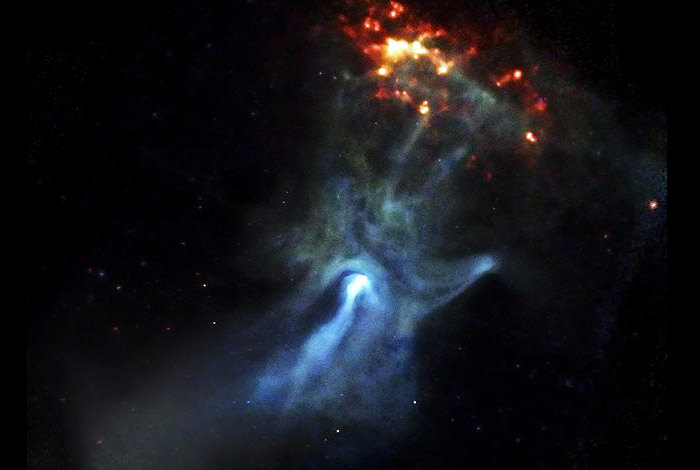
That spooky hand in the image above is producing questions for scientists. While the shape only coincidentally looks like a human hand, scientists are still trying to figure out how a small star produced such a large shape visible in X-rays.
Pulsar star PSR B1509-58 (or B1509 for short) is a 12-mile (19-kilometer) remnant of a much larger star that exploded and left behind a quickly spinning neutron star. Energy leaves mostly via neutrino (or neutral particle) emission, with a bit more coming out via beta decay, or a radioactive process where charged particles leave from atoms.
Using a new model, scientists found that so much energy comes out from neutrino emission that there shouldn’t be enough left for the beta decay to set off the X-rays you see here in this image, or in other situations. Yet it’s still happening. And that’s why they’re hoping to take a closer look at the situation.
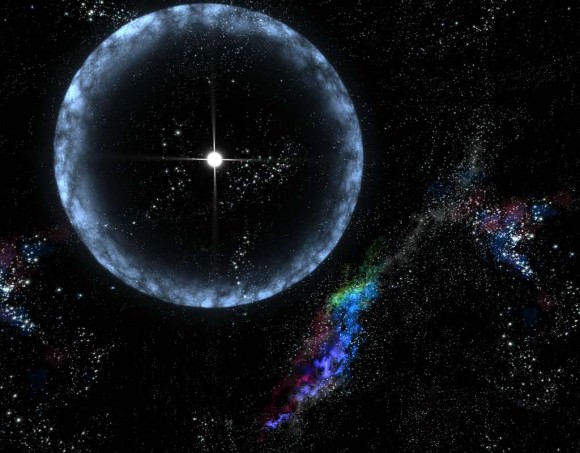
“Scientists are intrigued by what exactly powers these massive explosions, and understanding this would yield important insights about the fundamental forces in nature, especially on the astronomical/cosmological scale,” stated Peter Moller, who is with the theoretical division of Los Alamos National Laboratory and participated in the research.
Preliminary studies indicate that to better understand what’s happening on the surface of these objects, computer models must endeavor to “describe the shape of each individual nuclide” (or atom that has a certain number of protons and neutrons in its nucleus). That’s because not all of these nuclides are simple spheres.
Using facilities at Los Alamos, scientists created databases with different types of nuclides that had various beta-decay properties. They then plugged this into a Michigan State University model of neutron stars to see what energy was released as the stars accrete or come together.
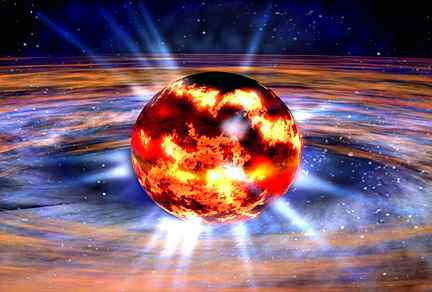
The results stood against what was a “common assumption”, the scientists stated, that the radioactive action would be enough to power the X-rays. They urge more study on this front, especially using a proposed Facility for Rare Isotope Beams that would be built at Michigan State, using funding from the U.S. Department of Energy Office of Science. FRIB project participants are hoping that will be ready in the 2020s.
You can read more about the research in the Dec. 1 edition of Nature. It was led by Hendrik Schatz, a professor at the National Superconducting Cyclotron Laboratory at Michigan State.
Source: Los Alamos National Laboratory
Why Does the Moon Shine?
We enjoy the light from the Sun during the day, and then the comforting glow of the Moon at night. But the light coming from the Moon is an illusion. As you know, you’re actually seeing the reflected light from the Sun, bouncing off the Moon which acts like a mirror. A really terrible mirror.
When astronauts walked on the surface, they reported that it was dark grey, the color of pavement. Because of its dark color and bumpy surface, it only reflects about 12% of the light that hits it. Additionally, the amount of light we get from the Moon depends on the point of its orbit.
During its first and last quarters, the Moon is half illuminated, but it’s only 8% as bright when it’s full. Just imagine the surface when its only partly illuminated. With the Sun at a steep angle, the mountains cast long shadows. This makes the lunar surface much darker than when it’s directly illuminated.
During the full Moon, it’s so bright that it obscures fainter objects in the night sky. Many astronomers put their telescopes away during this phase, and wait for it to go away. When the Moon is highly illuminated, it reflects so much light we can even see it during the day.
[/caption]
The brightness of the daytime sky completely washes out the light from the stars, but the Moon is even brighter, and so we can can see it in the sky during the day. The Moon follows an elliptical orbit around the Earth, changing its distance and brightness quite a bit. When it is at its closest point, and it’s full, this is known as a supermoon. This Moon can be 20% brighter than normal.
You’ve probably experienced how the Moon can cast shadows. In fact, there are three objects in the sky that can cast shadows. The Sun, of course, the Moon… and Venus.
Venus is the next brightest object in the sky, after the Moon. It reflects 65% of the sunlight that hits it. Every few months, Venus reaches its brightest time – that’s when you can see your shadow. On a night with no Moon, head far away from city lights. Let your eyes adjust and watch as your hand casts a shadow on a white piece of paper, illuminated only by Venus.
One last thought on reflected light.We talked about how bad a mirror the Moon is, reflecting only 12% of the light that hits it. That’s nothing. Saturn’s moon Enceladus, on the other hand, reflects about 99% of the light that falls on it. If astronauts ever get the chance to walk on the surface of Enceladus, it’ll feel like freshly fallen snow.
We have written many articles about the Moon for Universe Today. Here are some interesting facts about the Moon, and here are some Earth and Moon photos.
If you’d like more info on the Moon, check out NASA’s Solar System Exploration Guide on the Moon, and here’s a link to NASA’s Lunar and Planetary Science page.
We’ve also recorded an entire episode of Astronomy Cast all about the Moon. Listen here, Episode 113: The Moon, Part 1.
References:
http://lunarscience.nasa.gov/kids/moonshine
http://www-istp.gsfc.nasa.gov/stargaze/Smoon.htm
Heat Shield for 2014 Orion Test Flight Arrives at Kennedy Aboard NASA’s Super Guppy
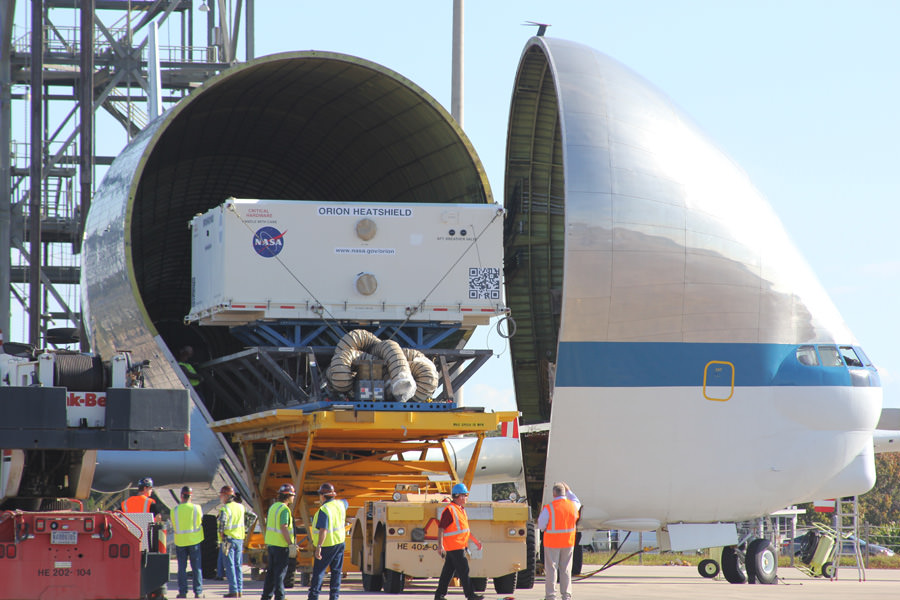
Orion EFT-1 heat shield is off loaded from NASA’s Super Guppy aircraft after transport from Manchester, N.H., and arrival at the Kennedy Space Center in Florida on Dec. 5, 2013. Credit: Ken Kremer/kenkremer.com
Story updated[/caption]
KENNEDY SPACE CENTER, FL – The heat shield crucial to the success of NASA’s 2014 Orion test flight has arrived at the Kennedy Space Center (KSC) aboard the agency’s Super Guppy aircraft – just spacious enough to fit the precious cargo inside.
Orion is currently under development as NASA’s next generation human rated vehicle to replace the now retired space shuttle. The heat shields advent is a key achievement on the path to the spacecraft’s maiden flight.
“The heat shield which we received today marks a major milestone for Orion. It is key to the continued assembly of the spacecraft,” Scott Wilson, NASA’s Orion Manager of Production Operations at KSC, told Universe Today during an interview at the KSC shuttle landing facility while the offloading was in progress.
“It will be installed onto the bottom of the Orion crew module in March 2014.”
The inaugural flight of Orion on the unmanned Exploration Flight Test – 1 (EFT-1) mission is scheduled to blast off from the Florida Space Coast in mid September 2014 atop a Delta 4 Heavy booster, Wilson told me.
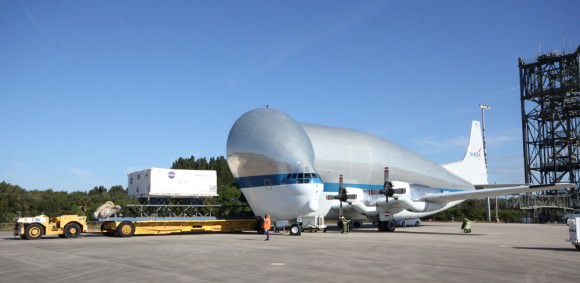
The heat shield was flown in from Textron Defense Systems located near Boston, Massachusetts and offloaded from the Super Guppy on Dec. 5 as Universe Today observed the proceedings along with top managers from NASA and Orion’s prime contractor Lockheed Martin.
“The Orion heat shield is the largest of its kind ever built. Its wider than the Apollo and Mars Science Laboratory heat shields,” Todd Sullivan told Universe Today at KSC. Sullivan is the heat shield senior manager at Lockheed Martin.
The state-of-the-art Orion crew capsule will ultimately enable astronauts to fly to deep space destinations including the Moon, Asteroids, Mars and beyond – throughout our solar system.
The heat shield was one of the last major pieces of hardware needed to complete Orion’s exterior structure.
“Production of the heat shields primary structure that carries all the loads began at Lockheed Martin’s Waterton Facility near Denver,” said Sullivan. The titanium composite skeleton and carbon fiber skin were manufactured there to give the heat shield its shape and provide structural support during landing.
“It was then shipped to Textron in Boston in March,” for the next stage of assembly operations, Sullivan told me.
“They applied the Avcoat ablater material to the outside. That’s what protects the spacecraft from the heat of reentry.”
Textron technicians just completed the final work of installing a fiberglass-phenolic honeycomb structure onto the heat shield skin. Then they filled each of the honeycomb’s 320,000 cells with the ablative material Avcoat.
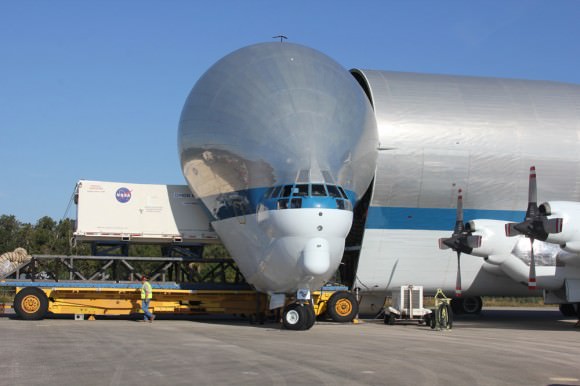
Each cell was X-rayed and sanded to match Orion’s exacting design specifications.
“Now we have about two and a half months of work ahead to prepare the Orion crew module before the heat shield is bolted on and installed,” Sullivan explained.
The Avcoat-treated shell will shield Orion from the extreme heat of nearly 4000 degrees Fahrenheit it experiences during the blazing hot temperatures it experiences as it returns at high speed to Earth. The ablative material will wear away as it heats up during the capsules atmospheric re-entry thereby preventing heat from being transferred to the rest of the capsule and saving it and the human crew from utter destruction.
“Testing the heat shield is one of the prime objectives of the EFT-1 flight,” Wilson explained.
“The Orion EFT-1 capsule will return at over 20,000 MPH,” Wilson told me. “That’s about 80% of the reentry speed experienced by the Apollo capsule after returning from the Apollo moon landing missions.”
“The big reason to get to those high speeds during EFT-1 is to be able to test out the thermal protection system, and the heat shield is the biggest part of that.”
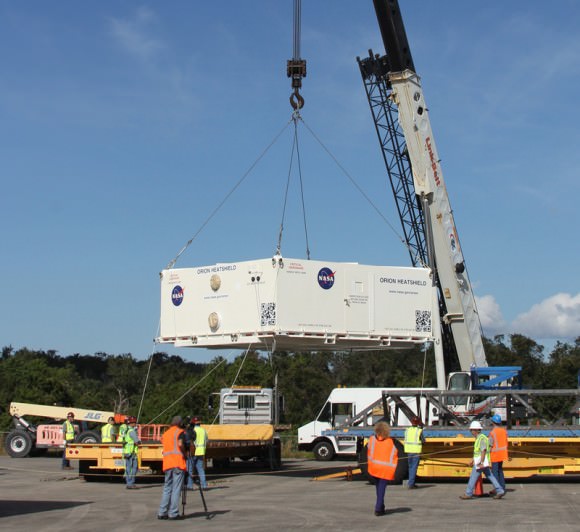
The two-orbit, four- hour EFT-1 flight will lift the Orion spacecraft and its attached second stage to an orbital altitude of 3,600 miles, about 15 times higher than the International Space Station (ISS) – and farther than any human spacecraft has journeyed in 40 years.
“Numerous sensors and instrumentation have been specially installed on the EFT-1 heat shield and the back shell tiles to collect measurements of things like temperatures, pressures and stresses during the extreme conditions of atmospheric reentry,” Wilson explained.
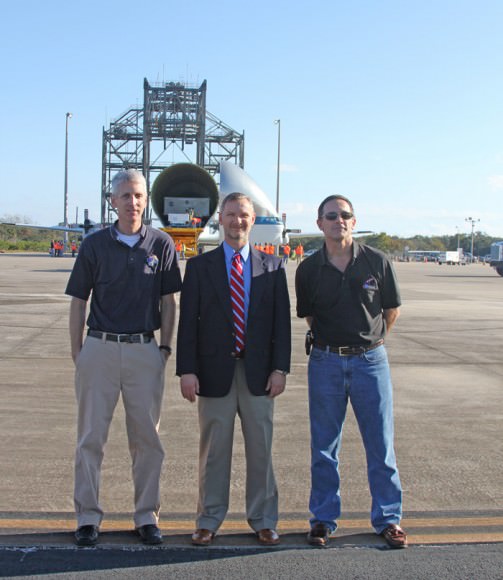
The data gathered during the unmanned EFT-1 flight will aid in confirming. or refuting, design decisions and computer models as the program moves forward to the first flight atop NASA’s mammoth SLS booster in 2017 on the EM-1 mission and human crewed missions thereafter.
“I’m very proud of the work we’ve done, excited to have the heat shield here [at KSC] and anxious to get it installed,” Sullivan concluded.
Stay tuned here for continuing Orion, Chang’e 3, LADEE, MAVEN and MOM news and Ken’s reports from on site at Cape Canaveral & the Kennedy Space Center press site.
…………….
Learn more about Orion, MAVEN, MOM, Mars rovers, Chang’e 3, SpaceX, and more at Ken’s upcoming presentations
Dec 10: “Antares ISS Launch from Virginia, Mars and SpaceX Mission Update”, Amateur Astronomers Association of Princeton, Princeton University, Princeton, NJ, 8 PM
Dec 11: “Curiosity, MAVEN and the Search for Life on Mars”, “LADEE & Antares ISS Launches from Virginia”, Rittenhouse Astronomical Society, Franklin Institute, Phila, PA, 8 PM
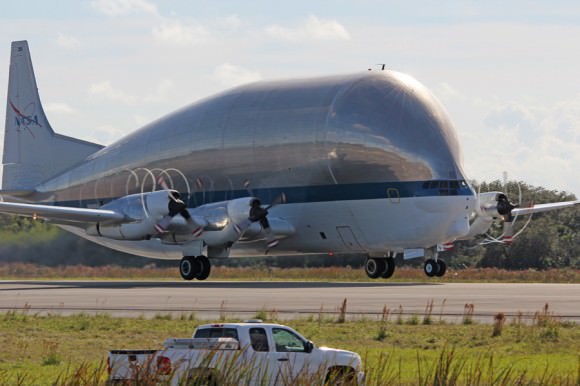
Little Big Universe: Tilt-Shifted Astro Images Make Space Look Tiny
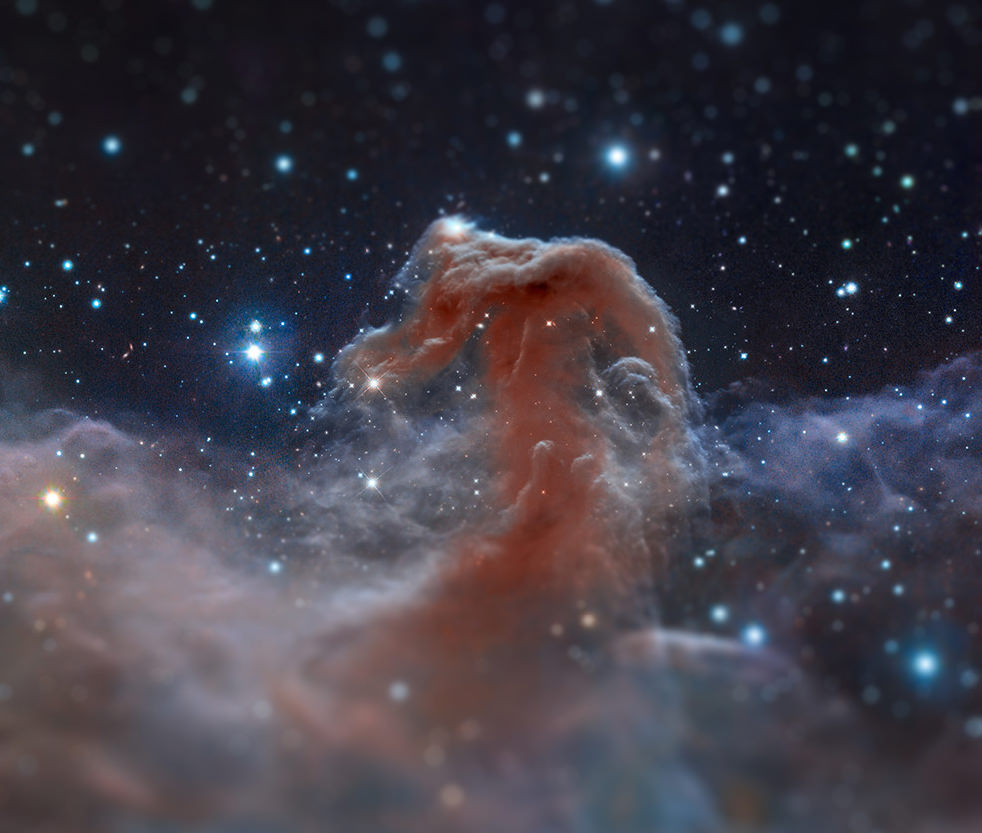
Aww, how cute! What an adorable little… nebula?
Although here it may look like it could fit in your hand, the Horsehead Nebula is obviously quite a bit larger – about 1.5 light-years across from “nose” to “mane.” But given a tilt-shift effect by Imgur.com user ScienceLlama, the entire structure takes on the appearance of something tiny — based purely on our eyes’ natural depth-of-field when peering at a small object close up. Usually done with Photoshop filters these days, it’s a gimmick, yes… but it works!
The original image was captured in infrared light by the Hubble Space Telescope and released in April 2013, in celebration of its 23rd anniversary.
Check out more of ScienceLlama’s “tiny universe” images below:
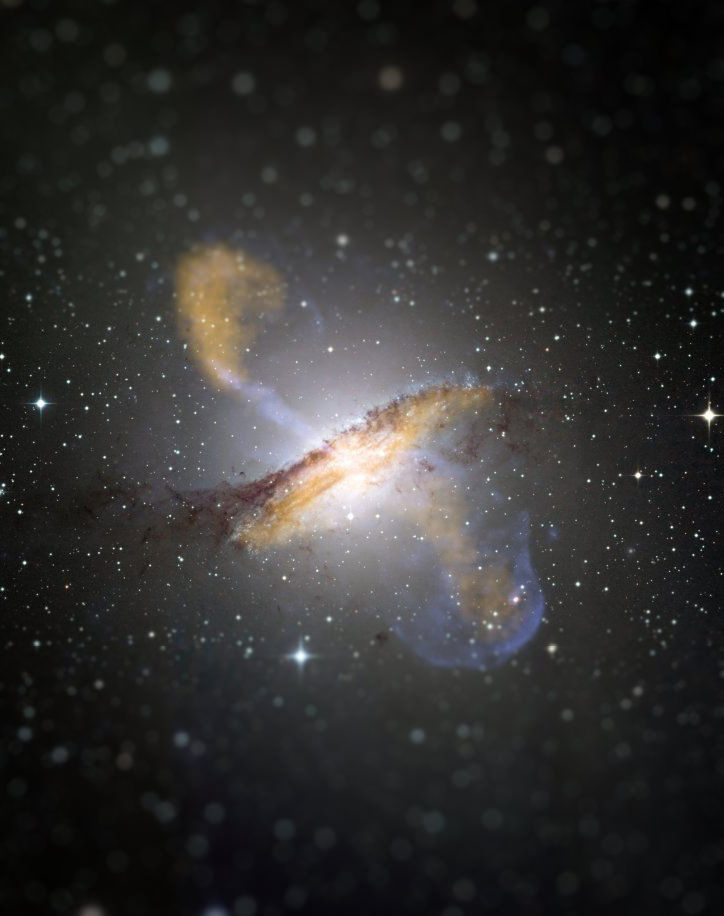
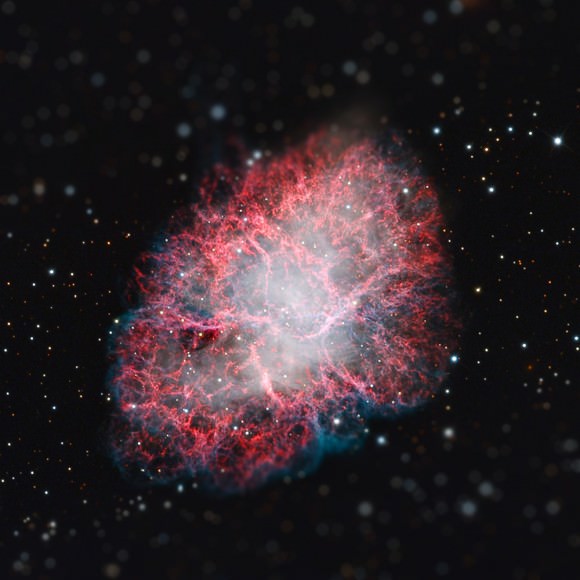
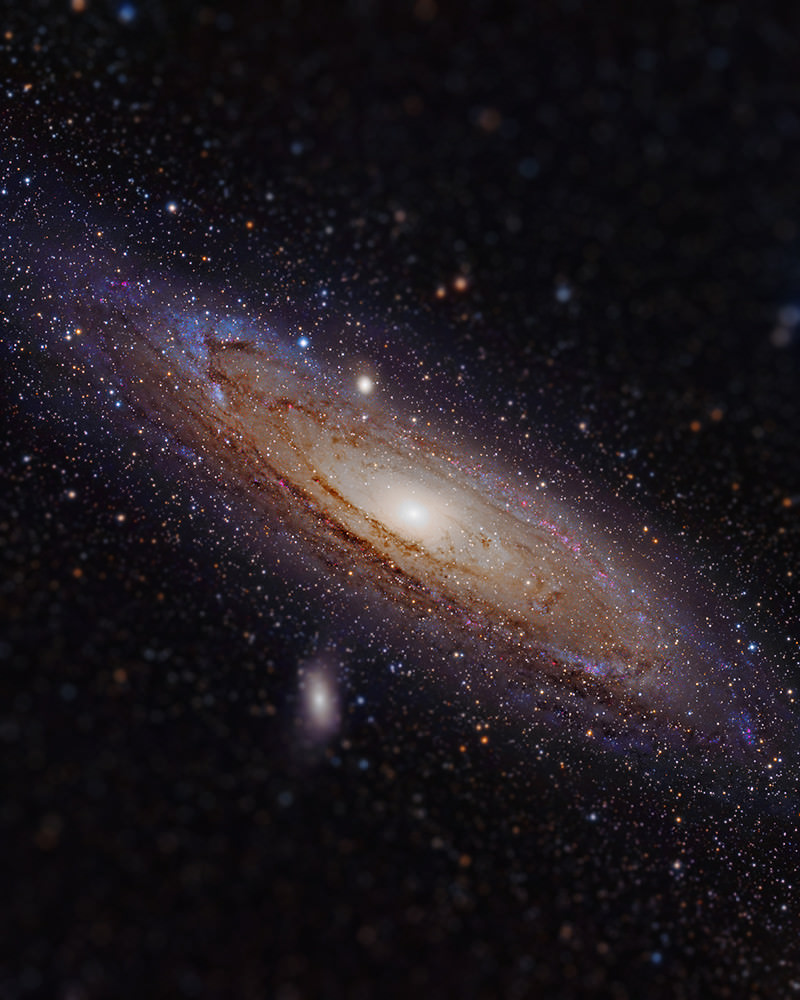
See these and more on ScienceLlama’s Imgur page here, and follow Science Llama on Twitter here.
(H/T to Google+ user Brian Koberlein and fellow Space Community member Warren Isaac. Featured on Reddit.com.)
ADDITION 12/17: Several of these images (like this one) were originally processed by Robert Gendler from Hubble-acquired data, but the attribution was not noted by ScienceLlama. I apologize for the oversight — see more of Robert’s beautiful astrophotography on his website here. Another original source was Adam Block of the Mount Lemmon Sky Center.
China’s Maiden Moon Rover Mission Chang’e 3 Achieves Lunar Orbit
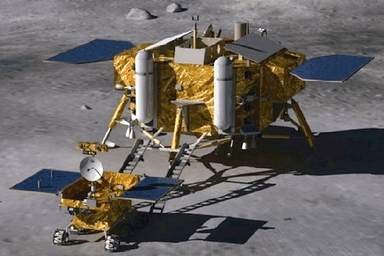
China’s maiden moon landing probe successfully entered lunar orbit on Friday, Dec. 6, following Sunday’s (Dec. 1) spectacular blastoff – setting the stage for the historic touchdown attempt in mid December.
Engineer’s at the Beijing Aerospace Control Center (BACC) commanded the Chang’e 3 lunar probe to fire its braking thrusters for 361 seconds, according to China’s Xinhua news agency.
The do or die orbital insertion maneuver proceeded precisely as planned at the conclusion of a four and a half day voyage to Earth’s nearest neighbor.
China’s ‘Yutu’ lunar lander is riding piggyback atop the four legged landing probe during the history making journey from the Earth to the Moon.

The critical engine burn placed Chang’e 3 into its desired 100 kilometer (60 mi.) high circular orbit above the Moon’s surface at 5:53 p.m. Friday, Beijing Time (4:53 a.m. EST).
An engine failure would have doomed the mission.
Chang’e 3 is due to make a powered descent to the Moon’s surface on Dec. 14, firing the landing thrusters at an altitude of 15 km (9 mi) for a soft landing in a preselected area called the Bay of Rainbows or Sinus Iridum region.
The Bay of Rainbows is a lava filled crater located in the upper left portion of the moon as seen from Earth. It is 249 km in diameter.
The variable thrust engine can continuously vary its thrust power between 1,500 to 7,500 newtons, according to Xinhua.
The lander is equipped with terrain recognition equipment and software to avoid rock and boulder fields that could spell catastrophe in the final seconds before touchdown if vehicle were to land directly on top of them.
The voyage began with the flawless launch of Chang’e 3 atop China’s Long March 3-B booster at 1:30 a.m. Beijing local time, Dec. 2, 2013 (12:30 p.m. EST, Dec. 1) from the Xichang Satellite Launch Center, in southwest China.
If successful, the Chang’e 3 mission will mark the first soft landing on the Moon since the Soviet Union’s unmanned Luna 24 sample return vehicle landed nearly four decades ago back in 1976.
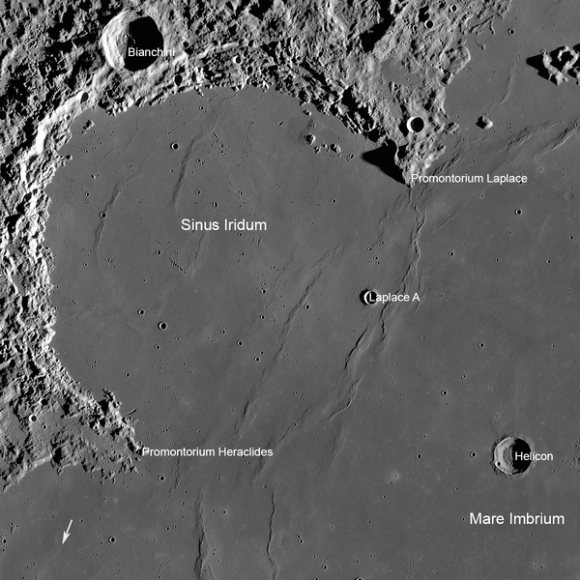
The name for the ‘Yutu’ rover – which means ‘Jade Rabbit’ – was chosen after a special naming contest involving a worldwide poll and voting to select the best name.
‘Yutu’ stems from a Chinese fairy tale, in which the goddess Chang’e flew off to the moon taking her little pet Jade rabbit with her.
The six-wheeled ‘Yutu’ rover will be lowered in stages to the moon’s surface in a complex operation and then drive off a pair of landing ramps to explore the moon’s terrain.
Yutu measures 150 centimeters high and weighs approximately 120 kilograms.
The rover and lander are equipped with multiple cameras, spectrometers, an optical telescope, radar and other sensors to investigate the lunar surface and composition.
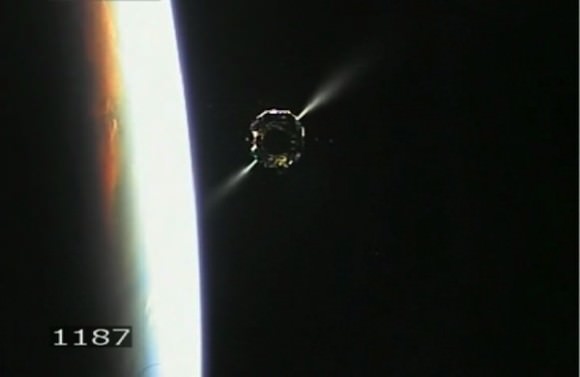
Chang’e 3 marks the beginning of the second phase of China’s lunar robotic exploration program.
The lander follows a pair of highly successful lunar orbiters named Chang’e 1 and 2 which launched in 2007 and 2010.
The next step will be an unmanned lunar sample return mission, perhaps by 2020.
China’s Chang’e 3 probe joins NASA’s newly arrived LADEE lunar probe which entered lunar orbit on Oct. 6 following a similarly spectacular night time blastoff from NASA’s Wallops Flight Facility in Virginia.
Stay tuned here for continuing Chang’e 3, LADEE, MAVEN and MOM news and Ken’s SpaceX and MAVEN launch reports from on site at Cape Canaveral & the Kennedy Space Center press site.
…………….
Learn more about Chang’e 3, SpaceX, MAVEN, MOM, Mars rovers, Orion and more at Ken’s upcoming presentations
Dec 10: “Antares ISS Launch from Virginia, Mars and SpaceX Mission Update”, Amateur Astronomers Association of Princeton, Princeton University, Princeton, NJ, 8 PM
Dec 11: “Curiosity, MAVEN and the Search for Life on Mars”, “LADEE & Antares ISS Launches from Virginia”, Rittenhouse Astronomical Society, Franklin Institute, Phila, PA, 8 PM

